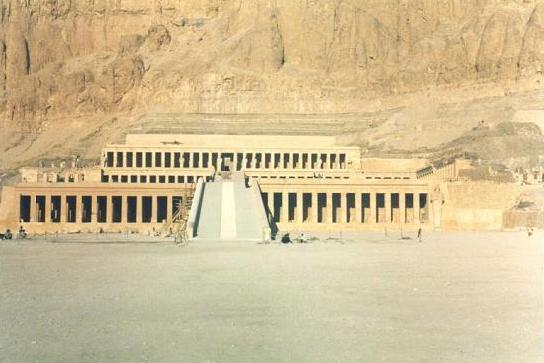|
The Temple Djeser djeseru |
last update:
26.04.2009
|


| Photo of Djeser djeseru (Holy of Holiest), the temple of
Maat-ka-Ra Hatshepsut at Deir el-Bahari, during the restoration work (1999); in front the 1.
ramp, on the left of of it the hall of obelisks, on the right of hall with
hunting scenes.
|
| The name Djeser djeseru is an abbreviation. The complete old Egyptian name
reads: "The great temple of million of years, the temple of Amun of Djeser djeseru at
his outstanding place of the first time". Therefore, among others the name points
to a "primeval hill" what probably became manifested in the terraced
building.
|
| The building combined the functions of a temple to perform the cult
of gods, that of the king and the cult of the dead (king). The meaning of the name Djeser djeseru (_sr
Dsr.w-Jmn.w; the hieroglyphic writing is shown above the photo) is not clear
at all, in most cases the name is translated with "Holy of Holiest".
|
| According to the dedication textas, e.g. on the right and on the left
of the large niches on the upper terrace the temple is clearly dedicated to the Amun.
The chapels of the Hathor and the Anubis must be considered as "independent" parts of the temple
since these are provided with own dedication texts for these two divinities (see Grallert, 2001).
|
| The terraced temple of Hatshepsut at Deir el-Bahari which was completely built of limestone is probably one of the most well-known buildings not only
of Hatshepsut but of the whole inheritances of ancient Egypt. There is a lot
of material about this temple therefore special attention is given to this
building. On account of the large quantity
of the available material the location of the building, its history, the single
pillared halls (porticos) and the adjacent chapels are discussed each on an own
page. From these pages you can jump either back to this page (Djeser djeseru) or to
other pages.
|
|
![]()
